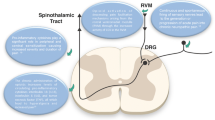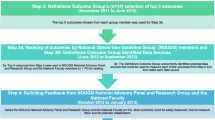ABSTRACT
The challenges facing patients and providers in managing ongoing opioid analgesic therapy for chronic pain are complex. Benefit of long-term opioid therapy, for which there are scant data, must be balanced against myriad potential undesired outcomes, including safety problems, ranging from mild toxicities to overdose and death; inadequate efficacy, which may mean continued patient suffering and unwarranted exposure to toxicities; and misuse of these potent medications. To help patients and providers navigate these challenges and optimize therapy, we present a research agenda in which we first characterize appropriate ongoing opioid prescribing and then describe three areas where quality improvement work is needed: 1) developing brief validated measures of patient-reported safety, efficacy, and misuse that improve outcomes; 2) designing evidence-based algorithms to guide changes in therapy when issues related to safety, efficacy or misuse are identified; and 3) promoting use of patient-centered, multi-modal treatment plans.
Similar content being viewed by others
REFERENCES
Centers for Disease Control and Prevention. Drug overdose deaths—Florida, 2003–2009. MMWR Morb Mortal Wkly Rep. 2011;60(26):869–72.
Becker WC, Fiellin DA. Federal plan for prescriber education on opioids misses opportunities. Ann Intern Med. 2012;157(3):205–6. doi:10.7326/0003-4819-157-3-201208070-00448.
Midboe A, Lewis E, Paik M, Gallagher R, Rosenberg J, Goodman F, et al. Measurement of adherence to clinical practice guidelines for opioid therapy for chronic pain. Transl Behav Med. 2012;2(1):57–64. doi:10.1007/s13142-011-0104-5.
Mosca L, Linfante AH, Benjamin EJ, Berra K, Hayes SN, Walsh BW, et al. National study of physician awareness and adherence to cardiovascular disease prevention guidelines. Circulation. 2005;111(4):499–510.
Kenny SJ, Smith PJ, Goldschmid MG, Newman JM, Herman WH. Survey of physician practice behaviors related to diabetes mellitus in the U.S. Physician adherence to consensus recommendations. Diabetes Care. 1993;16(11):1507–10.
Chou R, Fanciullo GJ, Fine PG, Adler JA, Ballantyne JC, Davies P, et al. Clinical guidelines for the use of chronic opioid therapy in chronic noncancer pain. J Pain. 2009;10(2):113–30.
The Management for Opioid Therapy for Chronic Pain Working Group. VA/DoD Clinical Practice Guideline for Management of Opioid Therapy for Chronic Pain. 2.0 ed. Department of Veterans Affairs, Department of Defense, editors: Office of Quality and Performance; 2010.
Dobscha SK, Corson K, Perrin NA, et al. Collaborative care for chronic pain in primary care: a cluster randomized trial. JAMA. 2009;301(12):1242–52. doi:10.1001/jama.2009.377.
Kroenke K, Bair MJ, Damush TM, et al. Optimized antidepressant therapy and pain self-management in primary care patients with depression and musculoskeletal pain: a randomized controlled trial. JAMA. 2009;301(20):2099–110. doi:10.1001/jama.2009.723.
Butler SF, Budman SH, Fernandez KC, Houle B, Benoit C, Katz N, et al. Development and validation of the current opioid misuse measure. Pain. 2007;130(1–2):144–56.
Banta-Green CJ, Von Korff M, Sullivan MD, Merrill JO, Doyle SR, Saunders K. The prescribed opioids difficulties scale: a patient-centered assessment of problems and concerns. Clin J Pain. 2010;26(6):489–97.
Compton PA, Wu SM, Schieffer B, Pham Q, Naliboff BD. Introduction of a self-report version of the prescription drug use questionnaire and relationship to medication agreement noncompliance. J Pain Symptom Manag. 2008;36(4):383–95.
Passik SD, Kirsh KL, Whitcomb L, Portenoy RK, Katz NP, Kleinman L, et al. A new tool to assess and document pain outcomes in chronic pain patients receiving opioid therapy. Clin Ther: Int Peer-Reviewed J Drug Ther. 2004;26(4):552–61. doi:10.1016/S0149-2918%2804%2990057-4.
Knisely JS, Wunsch MJ, Cropsey KL, Campbell ED. Prescription opioid misuse index: a brief questionnaire to assess misuse. J Subst Abuse Treat. 2008;35(4):380–6.
Cella D, Yount S, Rothrock N, Gershon R, Cook K, Reeve B, et al. The Patient-Reported Outcomes Measurement Information System (PROMIS): progress of an NIH Roadmap cooperative group during its first two years. Med Care. 2007;45(5 Suppl 1):S3–S11.
DeWalt D, Revicki D. Importance of Patient-Reported Outcomes for Quality Improvement. National Quality Measures Clearinghouse; 2008.
Alam A, Gomes T, Zheng H, Mamdani MM, Juurlink DN, Bell CM. Long-term analgesic use after low-risk surgery: a retrospective cohort study. Arch Intern Med. 2012;172(5):425–30.
Gordon A, Callaghan D, Spink D, Cloutier C, Dzongowski P, O’Mahony W, et al. Buprenorphine transdermal system in adults with chronic low back pain: a randomized, double-blind, placebo-controlled crossover study, followed by an open-label extension phase. Clin Ther. 2010;32(5):844–60.
Chen JT, Fagan MJ, Diaz JA, Reinert SE. Is treating chronic pain torture? Internal medicine residents’ experience with patients with chronic nonmalignant pain. Teach Learn Med. 2007;19(2):101–5.
Nwokeji ED, Rascati KL, Brown CM, Eisenberg A. Influences of attitudes on family physicians’ willingness to prescribe long-acting opioid analgesics for patients with chronic nonmalignant pain. Clin Ther. 2007;29(Suppl):2589–602.
Nicolaidis C. Police officer, deal-maker, or health care provider? Moving to a patient-centered framework for chronic opioid management. Pain Med. 2011;12(6):890–7. doi:10.1111/j.1526-4637.2011.01117.x.
Sullivan MD, Gaster B, Russo J, Bowlby L, Rocco N, Sinex N, et al. Randomized trial of web-based training about opioid therapy for chronic pain. Clin J Pain. 2010;26(6):512–7.
Acknowledgments
Dr. Becker was supported by a Veterans Health Administration Health Services Research & Development Career Development Award (08-276); Dr. Fraenkel was supported by NIAMS K24 AR060231-01; Dr. Kerns was supported by VA Health Services Research and Development Research Enhancement Award Program (REA 08-266); Dr. Fiellin was supported by NIDA R01-DA020576-01A1 and NIAAA U01-AA020795-01.
Disclaimer
The views expressed in this article are those of the authors and do not necessarily reflect the position or policy of the Department of Veterans Affairs or the United States government.
Conflict of Interest
The authors declare that they do not have a conflict of interest.
Author information
Authors and Affiliations
Corresponding author
Rights and permissions
About this article
Cite this article
Becker, W.C., Fraenkel, L., Kerns, R.D. et al. A Research Agenda for Enhancing Appropriate Opioid Prescribing in Primary Care. J GEN INTERN MED 28, 1364–1367 (2013). https://doi.org/10.1007/s11606-013-2422-4
Received:
Revised:
Accepted:
Published:
Issue Date:
DOI: https://doi.org/10.1007/s11606-013-2422-4




